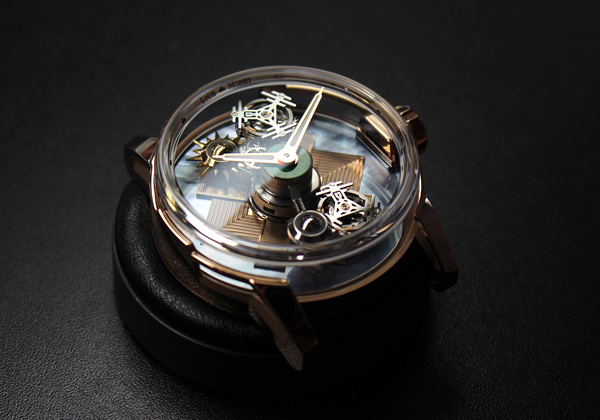The spirit of creation
The MAYA ECLIPSE embodies the beguiling cosmic phenomenon that is the eclipse, using technology to capture a poetic beauty. It plays out the spectacular encounter between the moon and the sun 18 times per hour, with the magical axis of the Kukulcán Pyramid serving as its centre point.
Mayan society and culture drew an important association between astronomy, the vision of the Cosmos, religion and politics. Brilliant mathematicians and architects, the Mayans were also fervent observers of the stars and other celestial phenomena. They used their observations to create various calendars, some of which were highly complex and extremely accurate. They used these to measure time, enabling them to determine the phases of the moon and the position of the sun during eclipses, solstices and equinoxes.
This unique creation combines striking elements of Mayan culture with the watchmaking expertise of Ateliers Louis Moinet. The concept was developed by the young jewellery artist, Nathanaël Schaller, national winner of the French Prix des Métiers d'Art in 2020.

When the stars align
Pyramidal architecture features in the shape of the watch's mysterious and complex movement, whose stepped construction projects from the centre. This movement has two satellite tourbillons that rotate in opposite directions, with their counterweights representing a moon and a sun inspired by Mayan symbols. They cross and overlap 18 times per hour, i.e. 432 times per day, with each meeting producing a striking and poetic eclipse, from where the timepiece gets its legendary name: MAYA ECLIPSE.
At the top of the movement's mechanical axis sits a fragment of jade. Its position at the top of the pyramid is symbolic, since jade was considered more precious than gold by the Mayans, who used it to make various artefacts to feature in their rites and ceremonies.

Chichén Itza in a new light
The back of the dial is made from coloured mother-of-pearl, an exquisite and ethereal material which reminds us that the Kukulcán Pyramid is built over a cenote. Cenotes are natural pits primarily found in North and Central America. Usually filled with fresh water (though sometimes with sea water), they were considered sacred by the Mayans. The transparent flange features hour-markers with Mayan numerals made up of lines and dots. These graphical elements make for easy time reading.
The pyramid is made from 18k 5N rose gold and is adorned with guilloché geometric patterns that play with light and shade to stunning effect. This recalls the phenomenon that occurs at the Kukulcán Pyramid itself during equinoxes: the sun strikes the north-west corner of the pyramid, creating the illusion that the serpent is descending the steps of the pyramid.

The MAYA ECLIPSE depicts the Kukulcán Pyramid seen from the above, with its nine levels and four staircases. This construction symbolises the cosmic axis that links the infraworld, the world of the living and the world of the gods. It is located at the site of Chichén Itzá in Mexico, and is dedicated to Kukulcán, the feathered serpent. Kukulcán was the all-powerful god of resurrection and reincarnation worshipped by the Mayans.




